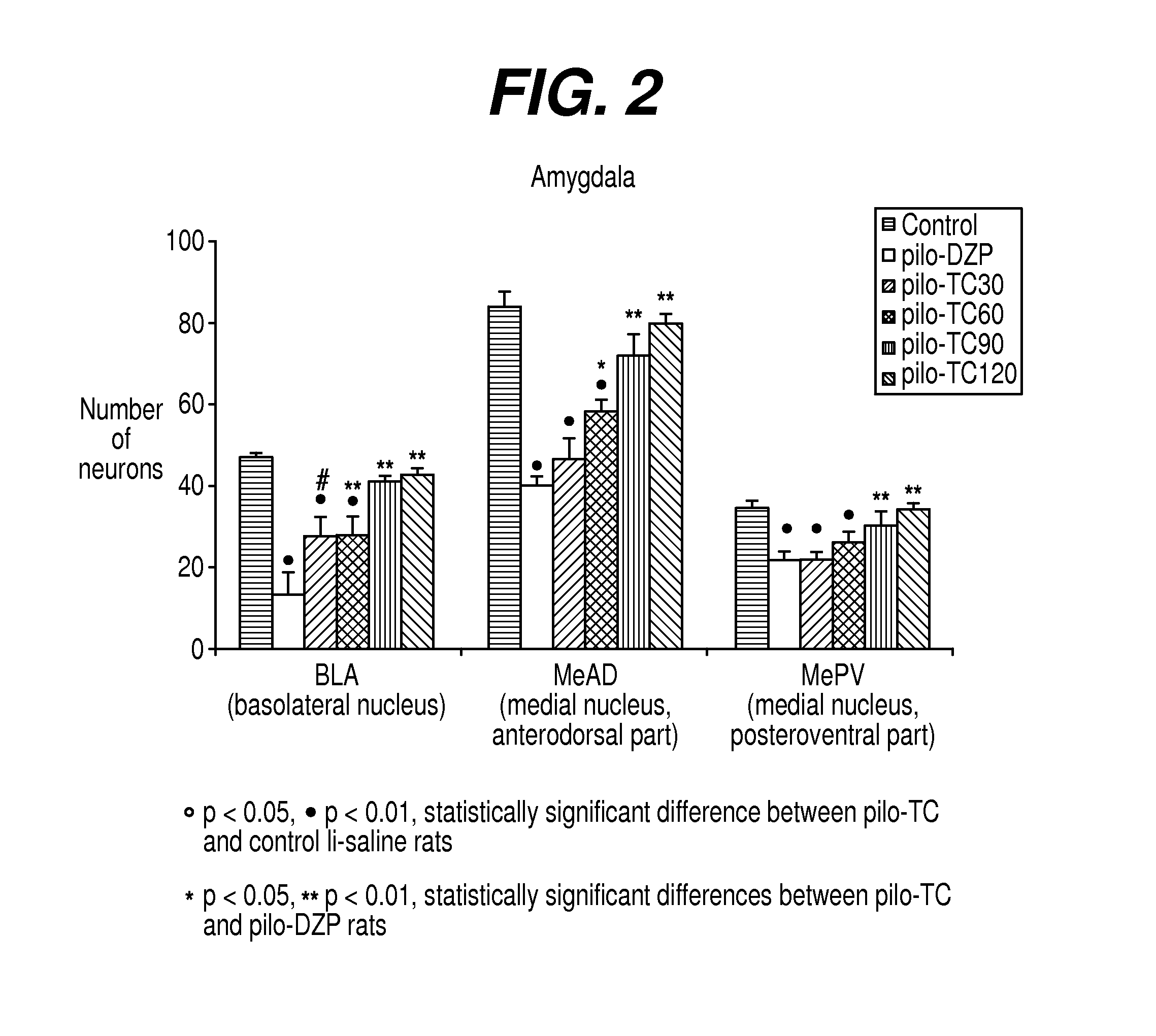Methods of treating epileptogenesis and epilepsy
a technology of epilepsy and epilepsy, applied in the field of epileptogenesis and epilepsy, can solve the problems of individual becoming more susceptible to recurrence, debilitating symptoms of seizure or seizure-related disorder, etc., to prevent the initial development and maturation, suppress epileptic seizures, and powerfully anti-epileptic
- Summary
- Abstract
- Description
- Claims
- Application Information
AI Technical Summary
Benefits of technology
Problems solved by technology
Method used
Image
Examples
examples
[0237]The activity of an isolated S-enantiomer of Formula 1 (e.g., Formula 7), herein referred to as the “Test Compound” or “TC” or “test compound” was evaluated in the following experiments to determine the efficacy of the compound for neuroprotection and in the treatment of epileptogenesis in the model of temporal lobe epilepsy induced by lithium and pilocarpine in the rat.
Example -b 1
The Lithium-Pilocarpine Model of Temporal Lobe Epilepsy
[0238]The model induced in rats by pilocarpine associated with lithium (Li-Pilo) reproduces most of the clinical and neurophysiological features of human temporal lobe epilepsy (Turski et al., 1989, Synapse 3:154-171; Cavalheiro, 1995, Ital J Neurol Sci 16:33-37). In adult rats, the systemic administration of pilocarpine leads to status epilepticus (SE). The lethality rate reaches 30-50% during the first days. In the surviving animals, neuronal damage predominates within the hippocampal formation, the piriform and entorhinal cortices, thalamus, a...
example 2
REFERENCES FOR EXAMPLE 2
[0295]André V, Marescaux C, Nehlig A, Fritschy J M (2001) Alterations of the hippocampal GABAergic system contribute to the development of spontaneous recurrent seizures in the lithium-pilocarpine model of temporal lobe epilepsy. Hippocampus 11:452-468.[0296]André V, Rigoulot M A, Koning E, Ferrandon A, Nehlig A (2003) Long-term pregabalin treatment protects basal cortices and delays the occurrence of spontaneous seizures in the lithium-pilocarpine model in the rat. Epilepsia 44:893-903.[0297]Cavalheiro E A (1995) The pilocarpine model of epilepsy. Ital J Neurol Sci 16:33-37.[0298]Dubé C, Marescaux C, Nehlig A (2000) A metabolic and neuropathological approach to the understanding of plastic changes occurring in the immature and adult rat brain during lithium-pilocarpine induced epileptogenesis. Epilepsia 41(Suppl 6):S36-S43.[0299]Dubé C, Boyet S, Marescaux C, Nehlig A (2001) Relationship between neuronal loss and interictal glucose metabolism during the chron...
example 3
[0305]The purpose of this study was to assess the pharmacokinetics (PK) of Test Compound (TC) following single and repeated oral administration in healthy adult men at clinically relevant doses
Methods:
[0306]Two single-center, placebo-controlled, double-blind, ascending-dose studies were conducted in healthy men ≧18 and ≦45 yrs. In study 1 (N=70), subjects were randomly assigned to a single dose of Test Compound (TC) or placebo. Escalated doses were received as 100, 250, 400, 750, 1000, 1250, and 1500 mg. PK parameters were estimated from plasma and urine samples collected up to 3 days post dose. Study 2 (N=53) evaluated the PK of repeated doses of Test Compound (TC) in 4 dose groups (100, 250, 500, or 750 mg). Within each group, 12 subjects were assigned to q12h treatment with drug or placebo for 1 wk and were crossed over after a 14-day washout period. PK parameters were estimated from plasma and urine samples on days 1 and 7.
Results:
[0307]Single dose: Test Compound (TC) was rapidl...
PUM
| Property | Measurement | Unit |
|---|---|---|
| frequency | aaaaa | aaaaa |
| weights | aaaaa | aaaaa |
| weights | aaaaa | aaaaa |
Abstract
Description
Claims
Application Information
 Login to View More
Login to View More - R&D
- Intellectual Property
- Life Sciences
- Materials
- Tech Scout
- Unparalleled Data Quality
- Higher Quality Content
- 60% Fewer Hallucinations
Browse by: Latest US Patents, China's latest patents, Technical Efficacy Thesaurus, Application Domain, Technology Topic, Popular Technical Reports.
© 2025 PatSnap. All rights reserved.Legal|Privacy policy|Modern Slavery Act Transparency Statement|Sitemap|About US| Contact US: help@patsnap.com



